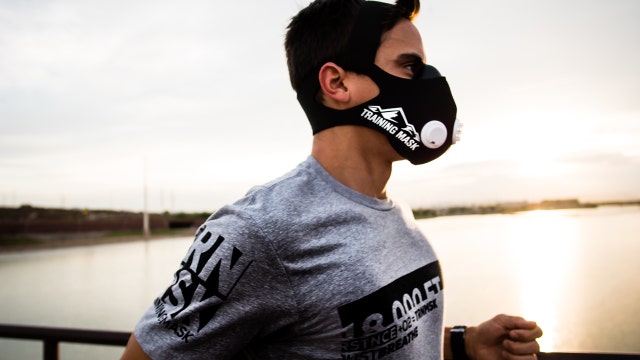Can an elevation training mask boost your fitness?
Q&A with Dr. Manny: I read athletes use elevation training masks to build up their lung capacity and improve their overall fitness, but do they really work?
Cyclists and long-distance runners have historically trained at higher altitudes (between 6,000 and 10,000 feet above seas level) then returned to sea level to improve their athletic performance. But if you’re not into climbing Mt. Everest, could a high altitude masks offer the same benefits?
We recently got this question from a viewer:
Dear Dr. Manny,
I was running around Central Park in NYC and saw a bunch of runners wearing elevation training masks. I read athletes use them to build up their lung capacity and improve endurance, but do they really work, and are they safe to use?
Thanks, Jack
At a higher altitude, the amount of oxygen in the air is reduced, and your body compensates for this by producing more hemoglobin— the protein in red blood cells that transports oxygen to tissues to create energy for your body. Over time, training at high altitudes is thought to create more hemoglobin in your body so that when you return to sea level, those extra red blood cells continue to carry more oxygen to your tissues and thus give you more energy to push yourself harder for a short period of time. However, studies suggest this extra boost lasts only for about 15 days before it fades and normalizes.
Some elevation masks stimulate altitude training by making your body work harder to breathe. Theses masks use a valve system to reduce the amount of airflow to the lungs, which forces you to take deeper breaths. This is what's known as "restricted-air training" or "inspiratory muscle training."
When lungs are pushed to work harder, the surface area in the alveoli— the tiny air sacs where the lungs and the bloodstream exchange carbon dioxide and oxygen, get stretched— making more room for blood and oxygen to flow. But Dr. Len Horovitz, a pulmonoligist a Lenox Hill Hospital in New York, is skeptical of its stretching capability.
“You can’t really increase your lung capacity past a certain point,” Horovitz told FoxNews.com. It’s not completely elastic that you can keep stretching it like taffy. There is a limit.”
The idea behind the mask’s efficacy is that over time your lungs will adapt to this type of air resistance and use available oxygen more efficiently— and, as a result, increase your lung capacity and aerobic thresholds, too.
“The Training Mask 2.0 improves fitness and athletic performance by applying peripheral air resistance to inhaled air via six different elevation-resistance flux valve settings. The added load from this air resistance strengthens the respiratory musculature. In other words, it’s like lifting weights for your breathing muscles, which yields a number of benefits with continued use,” Casey Danford, CEO of Training Mask, told FoxNews.com.
While professional athletes like Marshawn Lynch from the Seattle Seahawks praise these training masks for giving them an extra boost before game time, not all experts support this type of training method.
“Unfortunately the air you're breathing when using a resistance [elevation] mask is of the same density and would be unlikely to cause an adaptive change, such as an elevation of your hemoglobin or blood oxygen carrying capacity,” Dr. Teo Mendez, a New York-based sports medicine doctor and a runner himself, told FoxNews.com. “And there is no evidence that resistance masks improve the ability of your body to use oxygen or increase performance.”
A 2016 study published in the Journal of Sports Science and Medicine reported the Training Mask 2.0 (ET mask) improved several areas of breathing performance. The report showed: improved ventilatory threshold (VT), an indirect measure of anaerobic threshold; power output (PO), or workload at VT; respiratory compensation threshold (RCT), the point late in exercise testing at very high workload; and PO at RCT while wearing the ET mask.
In the study, 24 moderately trained participants finished six weeks of high-intensity stationary cycling exercises two times a week for 30 minutes.
“It is hard to know what to make of those findings. If an improvement in aerobic capacity had occurred, VT and VO2max (maximal oxygen consumption) should have been increased along with the increase in RCT, and although VT and VO2max averaged slightly higher in ET mask than control subjects, the differences were not statistically significant,” Dr. Thomas Aldrich, an attending physician of Pulmonary Medicine at Montefiore Health System, told FoxNews.com. “By convention, scientists consider that to mean that we have neither proven nor disproven the hypothesis that the ET mask improved VT or VO2max better than the control mask.”
Although research on elevation training masks have stirred debate among scientists and proponents of the technology, Aldrich further warned the devices come with certain risks that consumers should be aware of.
“Inspiratory resistance breathing causes strong intrathoracic negative pressure swings. In dehydrated individuals, that can impair venous return into the chest and heart, reducing left ventricular output, possibly causing syncope— or passing out,” said Aldrich, who is a professor of pulmonary medicine at Albert Einstein College of Medicine.
Even in well-hydrated individuals, if they have uncontrolled hypertension or any kind of cardiac problems that they’re not aware of, this type of pressure could potentially have serious consequences, Aldrich added.
The Training Mask 2.0 costs $79.99 and can be purchased online, as well as at some sports retailers including Dick’s Sporting Goods, Academy Sports and Dunham’s.
Remember, you should always talk to your doctor before making any major changes to your fitness regime.
Do you have a health question for Dr. Manny? Please tweet it to @drmannyonFOX





















